 |
|
|
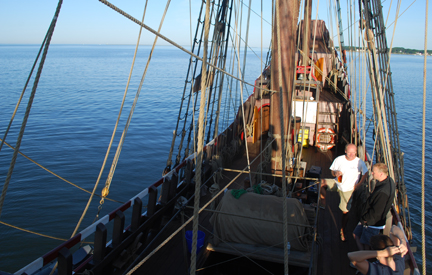
0630 hours
Current Position: Anchored at Duck Island Roads, CT.
Latitude: N 41˚ 15.8'
Longitude: W 072˚ 28.8'
Day Three of the first leg of the 2011 Fresh River Voyage of Discovery.
Today marks our final day on Long Island Sound and a gradual switch in focus from sailing to science, as well as a field trip up the Lieutenant River. Or should we call it shore leave?
|
Mouse over to
walk the capstan!
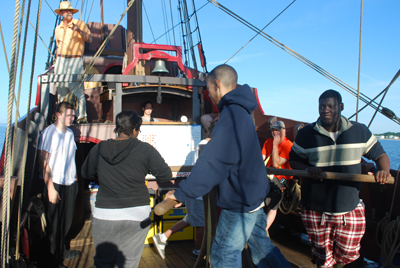 |
0730 hours
But first, it's time to put some mechanical advantage to good use. All hands in position to weigh anchor! After the anchor rode has been run out, the capstan team walks it in.
|
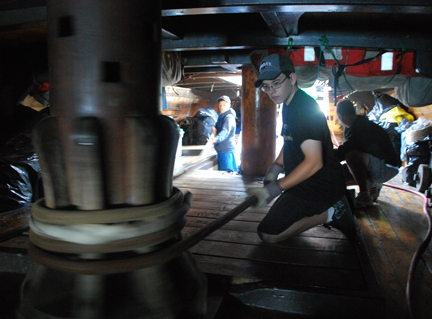
We cycle crew members through different positions to give everyone the chance to experience each part of the process. Jacob monitors the rode as it passes around the lower capstan this morning.
|
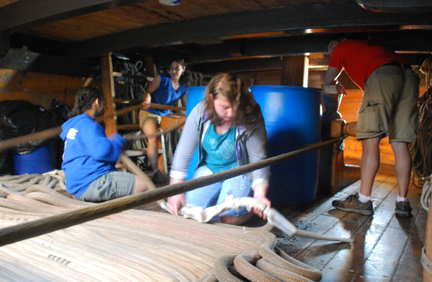
At the bow, Ms. Read is tending the bits, ready to make fast the rode (lash it to the bar) at any moment as a safety precaution. Lydia and Hannah are faking, and Mr. Roy is observing the rode as it enters the ship.
|
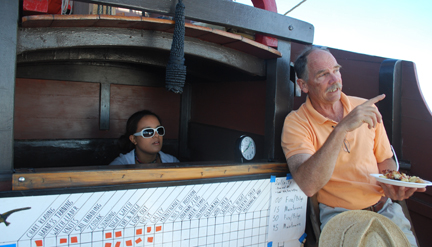
0815 hours
The anchor is soon secured; we set sail and on our way. Captain Reynolds gives Kristen some tips as she settles into her shift at helm. Sharp-eyed readers will also notice that the Task Matrix has started to fill out.
|
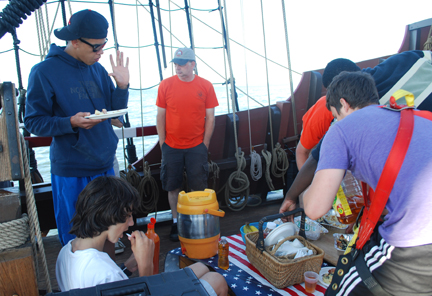
Moments later, the crew gobbles down the breakfast cassarole prepared by Mr. McLauglin's galley.
|
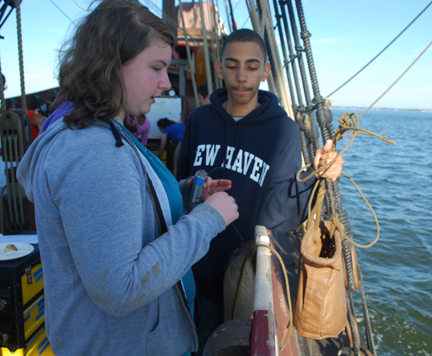
0830 hours
As we once again approach the mouth of the Connecticut River and the tidal boll it pushes out into Long Island Sound, the students grab their gear and repeat yesterday's experiment of comparing the temperature and salinity of the waters from the river and the sound.
|
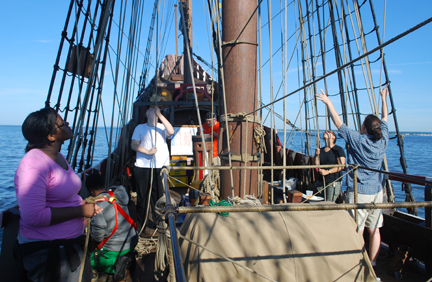
Our sail handlers continue to adjust for the wind as we continue eastward toward the Connecticut River's shipping channel.
|
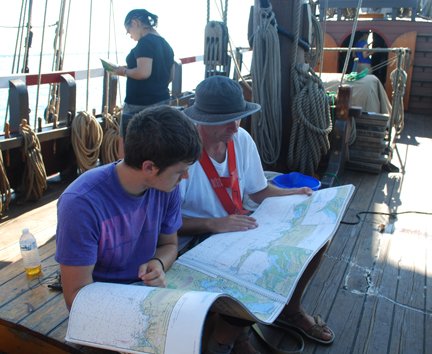
0845 hours
Mr. Shoemaker and Mr. de Jong sit on the main cargo hatch and use the modern nautical charts we've set out to familiarize themselves with the region. As we noted before, the northern coastline of Long Island Sound is home to many hidden hazards.
|
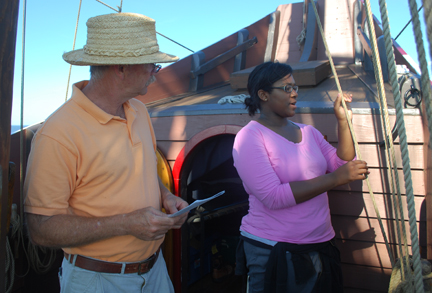
Meanwhile, Erica is climbing her way up the ranks again. As part of her test to requalify for the rank of Ordinary Sailor, she explains how rope is manufactured, and how that effects the methods we use to coil and preserve it.
|
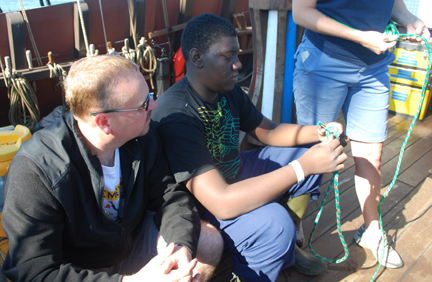
0915 hours
As our morning continues, many of the students are focused on learning how to tie new knots—a noteworthy skill both on the Task Matrix and in the Crew Rating Log.
|
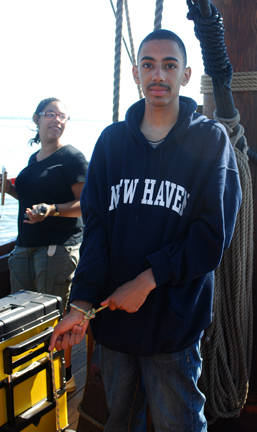 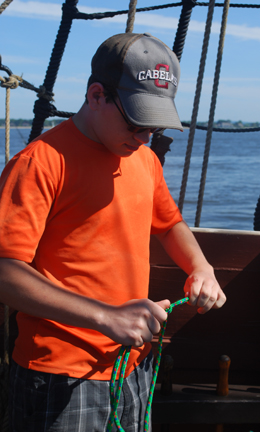
0930 hours
As the day winds on, a growing number of our student sailors learn to master knots like the bowline, the square knot, and the figure-eight. Each knot has it own special qualities and uses.
|
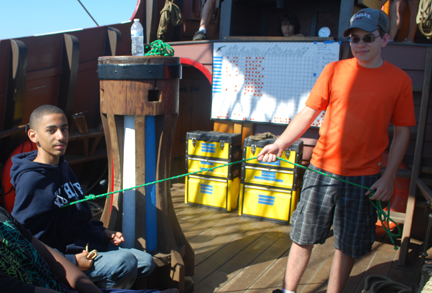
0945 hours
Jacob and Kelsey demonstrate the properties of the bowline knot. This essential knot creates a loop that does not cinch up on itself, making it useful for countless applications.
One such use is to tie a rescue line; if a person in distress (the role Kelsey is currently playing) ties a bowline around themselves, it won't constrict around them as they're pulled to safety.
|
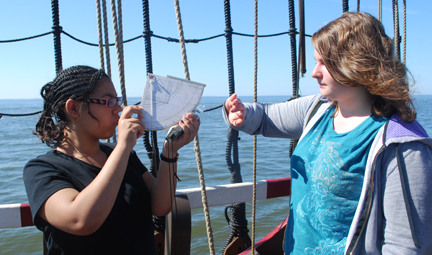
Hannah helps out Lydia as the latter takes a reading of the sun's elevation for the Celestial Tracking project. Rather than staring down the quadrant's sight directly as the sun, the students are trained to look away from the sun and look straight down the sights of the quadrant's shadow.
|
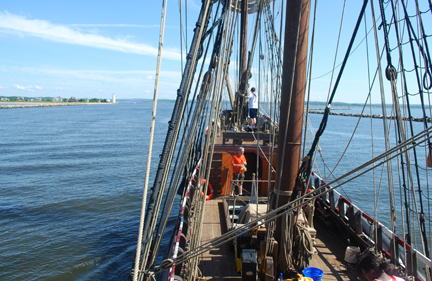
1000 hours
The Half Moon is now entering the mouth of the Connecticut River. The mouth itself is fairly wide, but deceptive; most of these waters conceal shallow sandbars, so traffic at the entrance is restricted to a narrow shipping channel.
|
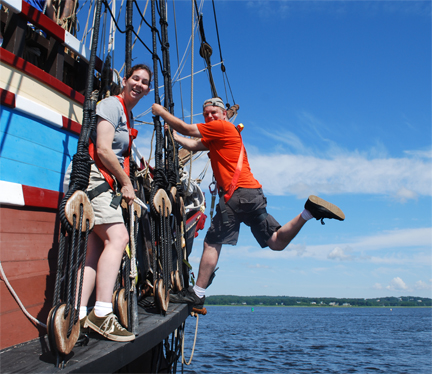
1015 hours
Just past the entrance the river's mouth widens slightly, granting ships with the Half Moon's 9-foot draft enough water depth to slip outside the main channel.
Ms. Reilly and Mr. Woodworth step onto the fore channel as we prepare to set anchor. Note that each in their own way, both are still maintaining three points of contact.
|
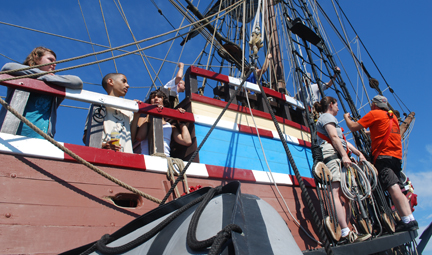
1030 hours
Mr. Woodworth is in position to guide the anchor down to the waterline with the aid of the fore deck crew. Ms. Reilly is equipped with a lead line, and will be taking soundings of our intended destination.
|
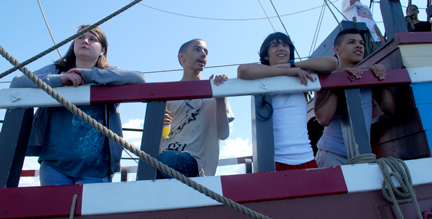
Several students—including the Height of Tide team of Hannah and Kelsey—take to the rail to watch the action.
|
Mouse over to cast the lead!
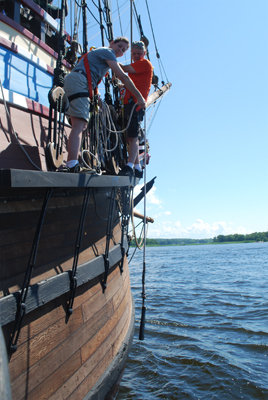 |
We have nautical charts showing the recorded depths of these waters, but a chart can't tell us if a sandbar has shifted since the chart was produced. We have no electronic depth finder on the Half Moon, so Ms. Reilly uses the traditional lead line to measure the actual depths for us as we edge toward today's anchorage.
|
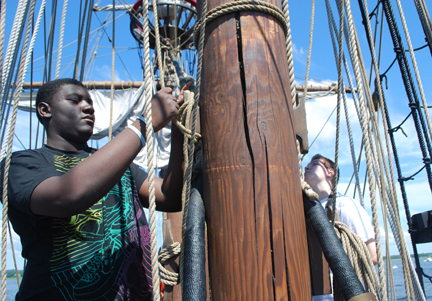
1045 hours
Jay and the rest of the fore mast team douse the fore course as we motor into position.
|
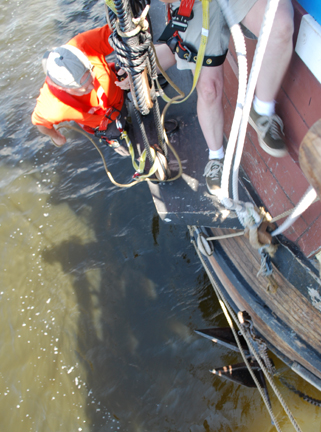
The camera catches the anchor suspended in midair a fraction of a second after Mr. Woodworth has yanked the fid free. An instant later, the anchor hits the water with a splash, securing the Half Moon just south of the Old Saybrook railway bridge.
|
Mouse over for an extreme close-up.
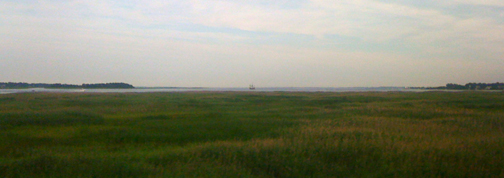 |
Current Position: Anchored off Old Saybrook, CT.
Latitude: N 41˚ 17.7'
Longitude: W 072˚ 20.8'
Coincidentally, while the Half Moon remains at anchor just south of the Old Saybrook railways bridge today, the Chronicler's brother happens to take a train across the bridge, spots us, and snaps this photo from across the Lieutenant River Salt Marsh. Can you spot the ship?
|
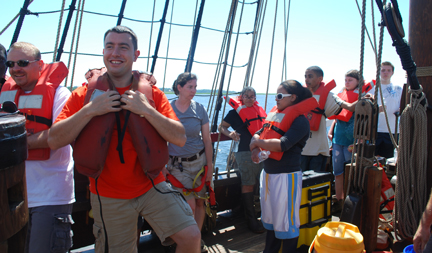
1115 hours
Don't worry, there's no emergency! The Connecticut River Academy crew have all donned their life vests because they're about to set out on a special shoreside expedition.
|
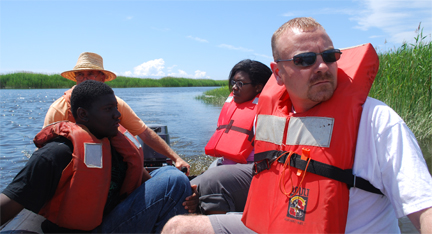
1145 hours
The salt marsh formed at the mouth of the Lieutenant River is a world-renowned protected ecology. With just a skeleton crew remaining on board the Half Moon to monitor the ship, everyone sets out for an afternoon of exploring this waterway. Thanks to Tony Roy for stepping in as photographer during this shoreside expedition.
|
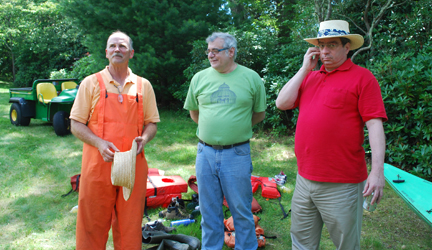
1200 hours
Our crew has been invited out as the guests of Phil (pictured, center) and Robin Schoenberger, friends of the Half Moon, who live right on the Lieutenant River. We're also accompanied by volunteer crew member David Pudlin (right).
|
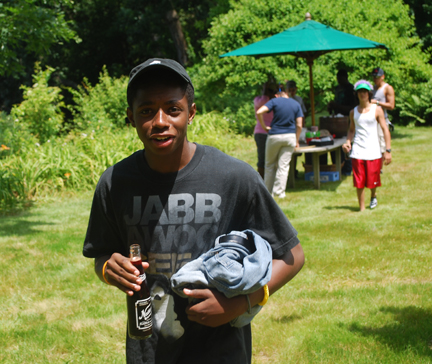
Before our explorations, our hosts treat the crew to lunch and some much-appreciated cold root beers.
|
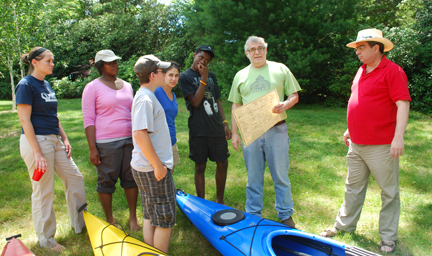
We've explored the mouth of the Lieutenant River Salt Marsh for years by strolling down the Connecticut DEP boardwalk, but today our hosts have given us our first opportunity to get up into the inner reaches of the marsh and the Lieutenant River.
|
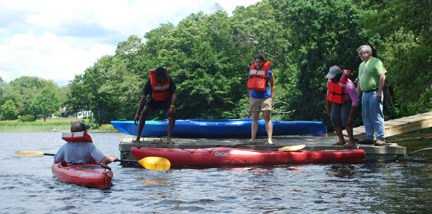
1230 hours
After lunch, our crew was shown to a waiting collection of kayaks.
|
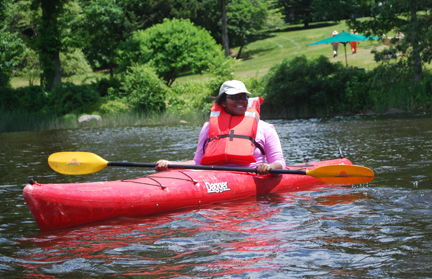
Our students spend most of the afternoon paddling through along the river. We'll let the pictures tell the story.
|
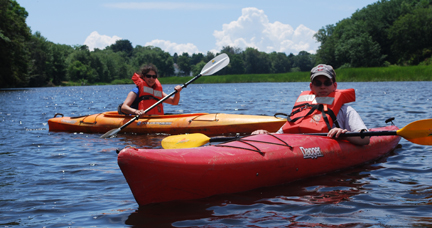
|
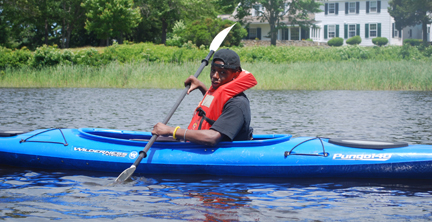
|
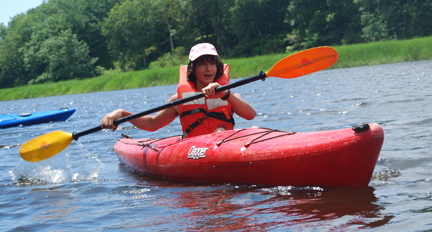
|
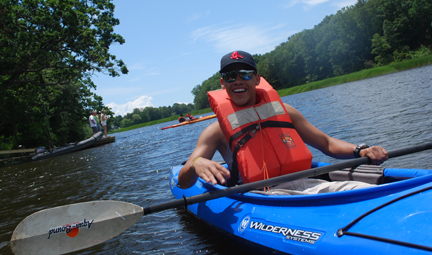
|
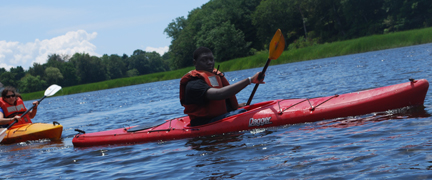
|
Mouse over for a close up!
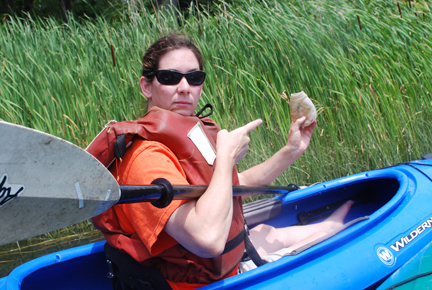 |
1300 hours
While out exploring, the teachers point out features of the environment, including an invasive plant species.
We also find a bit of plastic rubbish that's been carried in on the tide. Ms. Reilly does not approve, and we "rescue" the trash to properly dispose of it when we leave.
|
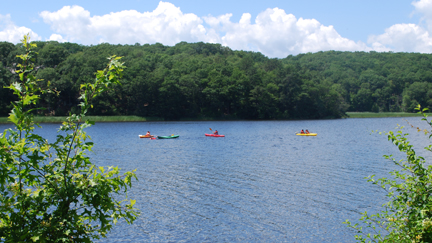
1400 hours
Eventually, the time comes to end our expedition up the Lieutenant River.
|
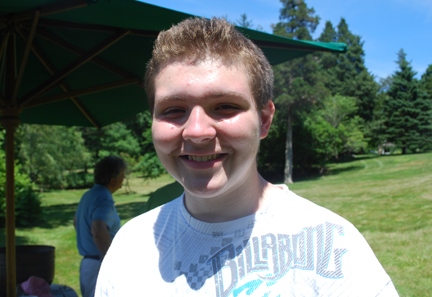
It seems to have gone well.
|
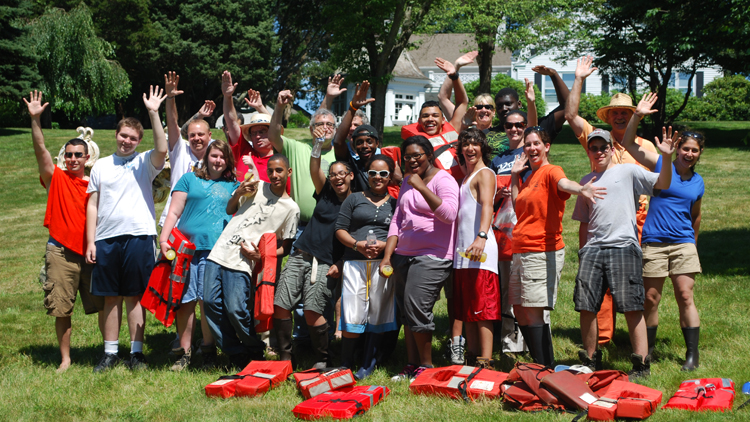
Thanks again to our gracious hosts! Thank-you notes are on their way!
|
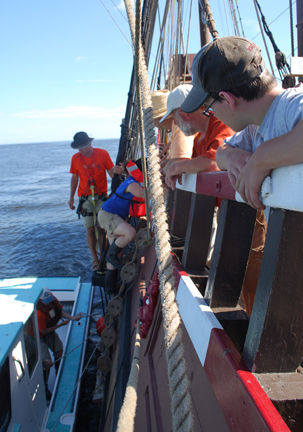
1630 hours
At long last, it's time to return to the ship...
|
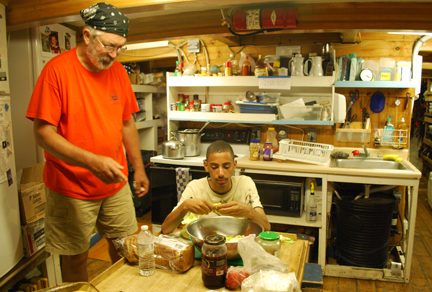
...and roll right back into work. The duty roster wait for no one! Kelsey reports to the galley to help Mr. McLaughlin prepare a salad to accompany tonight's dinner.
|
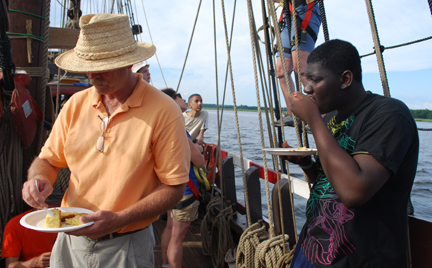
1730 hours
...and just like that, dinner is served! Tonight we're enjoying chile and cornbread.
|
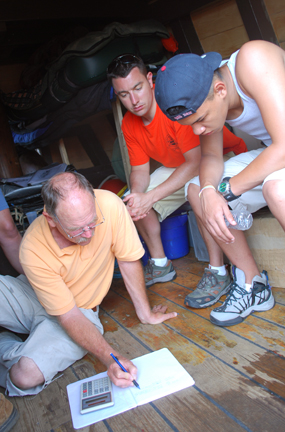
1800 hours
After dinner, the students refocus on their projects and shipboard activities. Captain Reynolds meets with the Current Speed research team to work out the calculations necessary to determine the rate of current.
|
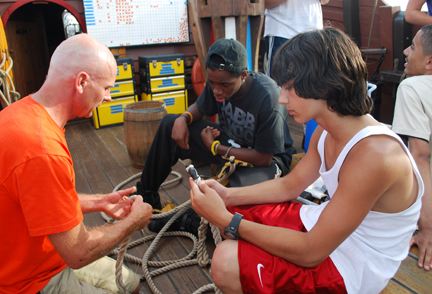
1830 hours
Mr. de Jong's whipping project also continues to garner new recruits.
|
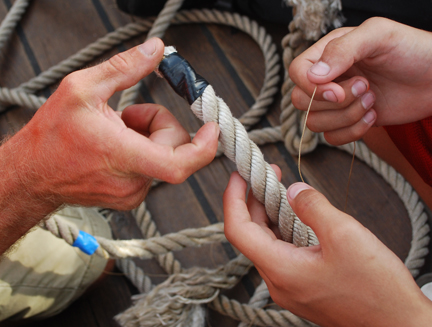
Mr. de Jong shows the section of line the whipping thread should cover.
A bit of tape wrapped around the end of the line serves as a temporary whipping, but such a jury-rigged solution is far from "ship shape." We want to replace this tape with tightly wound heavy thread as soon as we can.
|
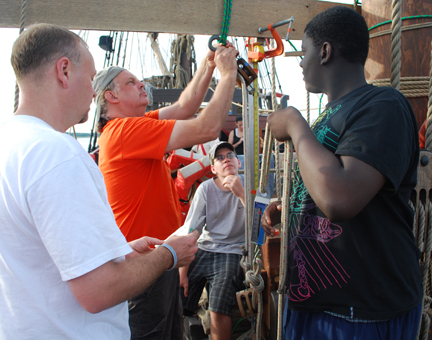
1845 hours
The Mechanical Advantage research team has set up their block-and-tackle rig and start taking measurements. Their work will continue into tomorrow afternoon.
|
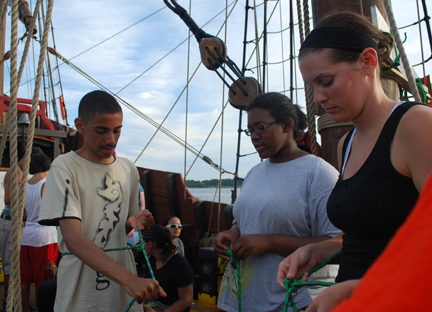
1900 hours
Kelsey has moved on to teaching his fellow crew mates how to use a bowline knot to create a rescue line.
|
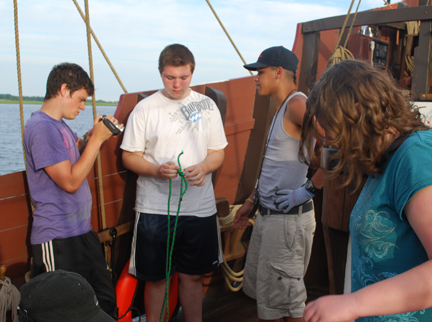
Mr. Shoemaker records the students' knot-tying skills for posterity. This is not a live broadcast; Mr. Shoemaker is simply shooting video that he'll later edit into a short piece to place online.
|
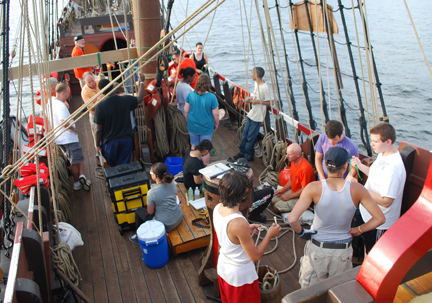
The weather deck remains abuzz with research projects and shipcraft work for the rest of the afternoon.
|
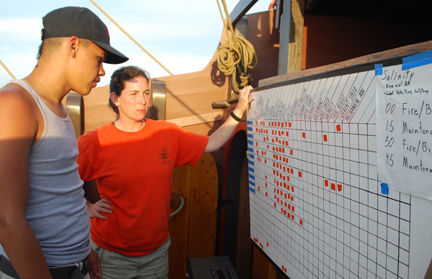
1945 hours
Eliu and Ms. Reilly check in with the Task Matrix to see what new accomplishments they can mark off.
|

The mechanical advantage team has finished taking measurements for the day. As the sun sets, they examine their findings to date.
|
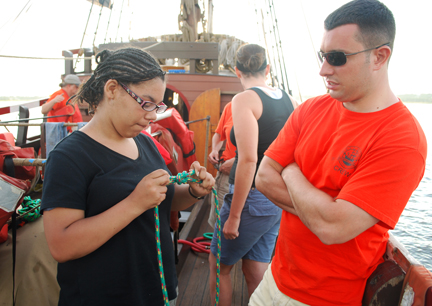
Knot tying continues apace as well. Lydia demonstrates a square knot for Mr. Roy.
|
Mouse over to produce the goods!
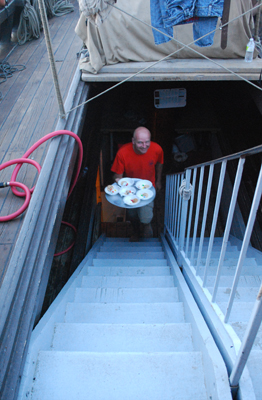 |
2030 hours
Suddenly, without warning, a luscious treat emerges from the galley...
|
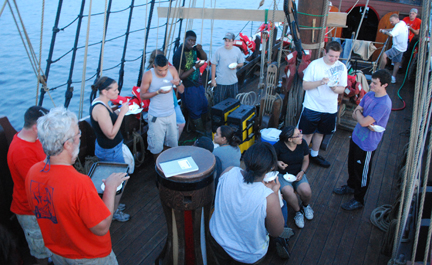
2045 hours
Everyone enjoys their ice cream during tonight's anchor watch briefing.
|
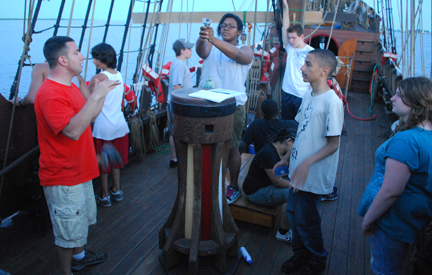
Ever-shifting weather patterns have required the Celestial Tracking research team to alter their plans. The forecast now warns that skies might be overcast tomorrow at midday, exactly when they need to see the sun to record its zenith. Since tracking the sun tomorrow is no longer guaranteed, they switch to a celestial tracking project that begins right now: tracking the star Altair. Along with Deneb and Vega, it's one of three bright stars that form the Summer Triangle. In order to track the stars throughout the night, the Celestial Tracking team must also train the Anchor Watch to record data for them.
|
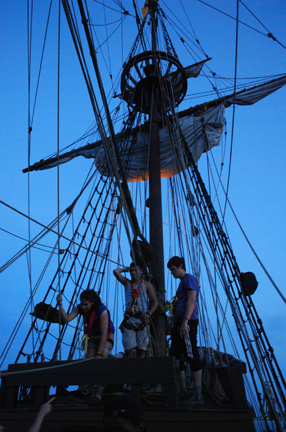
2100 hours
One last bit of ship's business to perform before we can call it a day: furling the sails. As the stars start to emerge, rig teams (now including student climbers) head aloft to secure the courses and topsails for the night.
|
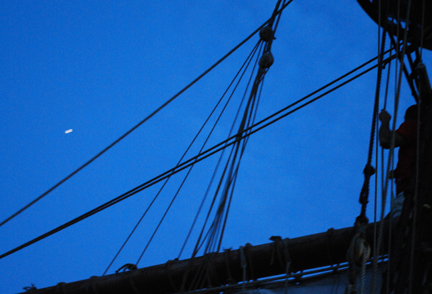
The brightest star to appear this evening isn't a star at all; that blur of light to the left of this image is the Inernational Space Station, zipping across the skies above (at an altitude of 51˚) over the course of just a few minutes.
|
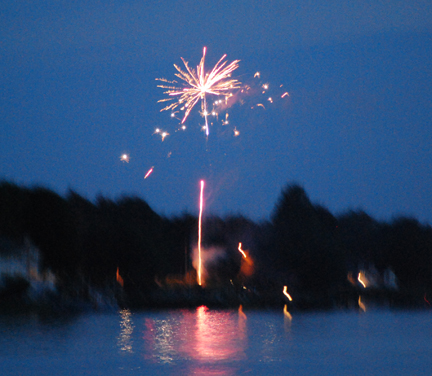
2115 hours
The other man-made lights we see tonight are closer to home. As the skies darken, we see numerous small, private fireworks displays lighting up the shoreline.
After the excitement settles down, we set up a few tarps just in case of rain, but in the end we enjoy clear skies.
Anchor Watch takes over at 2200 hours, and spends the night tracking the movement of the Summer Triangle.
Next Time: Heading Upriver!
|
|
|
|
|

